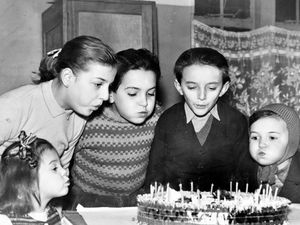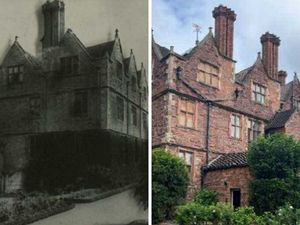A damaged castle, shattered windows and broken mirrors – when the earth moved in the West Midlands
It was 7.56 on a warm summer's morning, and Terry Wogan was presenting the Radio 2 breakfast show. And just as the veteran DJ was cranking up Good Vibrations by The Beach Boys, the West Midlands reverberated to vibrations of a very different kind.

On July 19, 1984, the region shook to the biggest earthquake since instrumental measures began.
While this week's tremor in Walsall may have got the West Midlands talking, it is a relative minnow compared to the earthquakes which have previously shaken the region.
While a few older readers may recall the Ludlow earthquake of 1926, which measured 4.8 on the Richter scale – and there was an earlier one in Stafford in 1916 – for most people there have been three notable shakes affecting the West Midlands within living memory: 1984, which had its epicentre in North Wales, 1990 in Bishop's Castle, south Shropshire, and 2002 in Dudley.
To put it into context, this week's earthquake measured 2.8 on the Richter scale, compared to 5.0 for the 2002 quake in Dudley. In other words, the Dudley quake was 158.5 times bigger than the one experienced this week.
But even that was pretty small compared to the one in 1984, which measured 5.4 on the Richter scale. This meant it was 2.5 times bigger than the 2002 quake – and 398 times stronger than Monday's tremor.
The 1984 quake, which had its epicentre at the Llyn Peninsular, was the largest on-shore earthquake to hit the UK since instrumental measures began. It lasted only a few seconds, but the effects were felt across most of England and Wales.
People were shaken off their feet and woken from moving beds as mirrors fell from walls, light fittings swung and foundations rocked.
But while one resident of Dudleston Heath in north Shropshire watched a mirror crash to the floor, the West Midlands escaped any serious damage.
The 1990 one, centred on Bishop's Castle, was another matter altogether. Measuring 5.2 on the Richter scale, it caused extensive damage, with Shrewsbury one of the worst-affected areas. Two streets in Shrewsbury were closed, one because of a gas leak, the other because of falling tiles and slates.
Many public buildings were evacuated, including West Mercia Police's headquarters, and the emergency services were deluged with calls following the main tremor at 2.30pm, which lasted for about five seconds.
For many, though, it will be the 2002 earthquake in Dudley that is freshest in the memory, even prompting Chris Tarrant to make a song about it.
The fact that its epicentre was just 500 yards from the famous Crooked House pub – which slopes so much that marbles appear to roll uphill when inside – doubtless added to the colour.
The quake struck at 12.53am on September 23, and the Midlands rocked for 20 whole seconds. Families fled into the streets, chimneys were shaken loose, glass shattered and walls cracked.
Crooked House manager Sue Holloway said:”I was just about to get into bed and I heard a rumble and then all of a sudden there was a big bang that sounded like an explosion and the building shook from side to side.”
Dudley Castle, which dates back to the 11th century, was damaged during the earthquake, splitting the stonework and sending bricks tumbling from the ruins.
Stones from the walls of the kitchen area, which dates back to the 16th century, fell to the ground.
Castle keeper Adrian Durkin said: “A brick arch in the castle kitchen chimney collapsed and a 12ft crack has appeared between two main walls.
“As a safety precaution we asked a structural engineer to take a look at it.
“Obviously the close proximity of the epicentre meant the castle structure was shaken quite badly.
“However it has been standing for more than a thousand years and the building must have experienced similar tremors in its long history.”
The epicentre was at the junction of High Arcal Road and Himley Road near Himley, but the effects were felt as far away as North Yorkshire, London, and Wiltshire.
West Midlands Police reported about 5,000 calls in the space of an hour after the quake, accompanied by a loud rumbling. Fire alarms were set off and people turned up at police stations in their nightclothes to ask what had happened.
Catherine Mortimer, of Achilles Close, Great Wyrley, was in the process of giving birth to a baby boy at Walsall Manor Hospital just as the earth began to shake.
Her sister Helen Steadman, aged 35, of Shelfield, Walsall, said: “The earthquake happened just as the little boy’s head appeared. They thought it was a bomb had gone off.
“But she just carried on and Max William was born. I don’t think my sister will ever forget it.”
Richard Flynn, of Oldbury, said: “The house started shaking quite violently at about 1am. All the power was cut off and seemed to be so for about a five-mile radius.
“The shaking and trembling was really quite severe. Quite a few people came out of their houses wondering what was going on. The streets were in darkness.”
Glenn Ford of the British Geological Survey said: “It’s an extremely large earthquake in UK terms but not large in world terms. We’d only classify it as a light earthquake.”
He added that the tremor was the equivalent of an explosion of 1,000 tons of TNT or a small nuclear weapon.
Or to put it another way, it was 631 times smaller than the 2015 earthquake that devastated Nepal.



